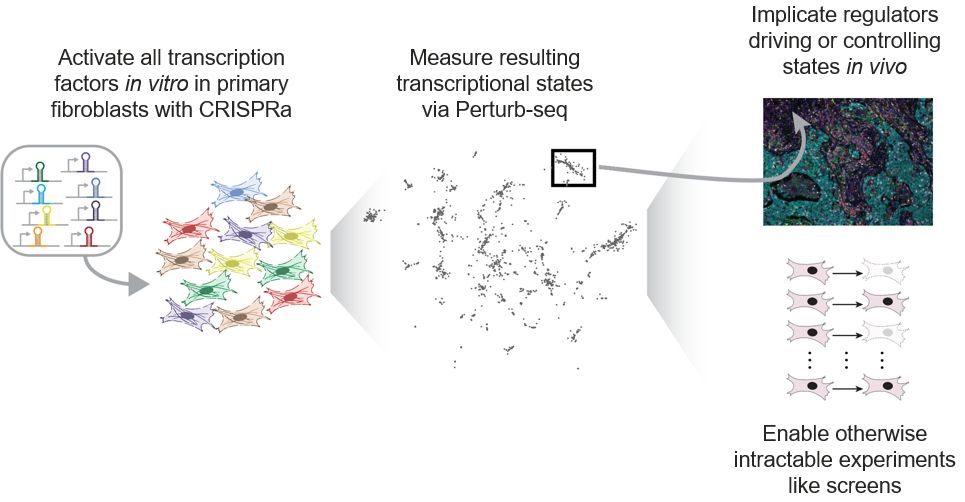Thomas Norman
@normanlab.bsky.social
Assistant Member in csBio at Memorial Sloan Kettering. Perturb-seq, single-cell functional genomics, and techniques for perturbing the genome.
Inflammatory fibroblasts secrete collagen. This enabled a striking experiment visualizing “state antagonism.” The pro-inflammatory TF EGR3 increases collagen expression, while the pro-universal TF KLF4 decreases it. When both are activated together, the effects cancel out.

August 6, 2025 at 3:14 PM
Inflammatory fibroblasts secrete collagen. This enabled a striking experiment visualizing “state antagonism.” The pro-inflammatory TF EGR3 increases collagen expression, while the pro-universal TF KLF4 decreases it. When both are activated together, the effects cancel out.
These comparisons let us identify TFs driving four fibroblast states described in the literature: universal, inflammatory, myofibroblast, and antigen presentation. Our in vitro signatures flag these subpopulations across four independent fibroblast atlases in a new main figure.

August 6, 2025 at 3:14 PM
These comparisons let us identify TFs driving four fibroblast states described in the literature: universal, inflammatory, myofibroblast, and antigen presentation. Our in vitro signatures flag these subpopulations across four independent fibroblast atlases in a new main figure.
A second challenge we encountered was surprisingly strong off-target effects from dCas9 binding at 3-5 nt sequences matching the protospacer seed region, which we could observe directly via CUT&RUN. This is a critical consideration for studies of enhancers and high MOI designs.

August 6, 2025 at 3:14 PM
A second challenge we encountered was surprisingly strong off-target effects from dCas9 binding at 3-5 nt sequences matching the protospacer seed region, which we could observe directly via CUT&RUN. This is a critical consideration for studies of enhancers and high MOI designs.
Takehome 2: CRISPRa has some practical challenges. Here I must include what may be the most popular part of the preprint, now known as Extended Data Fig. 1C. It shows the high failure rate of CRISPRa guides targeting a model target locus, CD45.

August 6, 2025 at 3:14 PM
Takehome 2: CRISPRa has some practical challenges. Here I must include what may be the most popular part of the preprint, now known as Extended Data Fig. 1C. It shows the high failure rate of CRISPRa guides targeting a model target locus, CD45.
Takehome 1: CRISPRa is a great tool for perturbing transcription factors (TFs). We observe that it usually leads to physiological expression levels, which is a key advantage over ORF overexpression for some use cases.

August 6, 2025 at 3:14 PM
Takehome 1: CRISPRa is a great tool for perturbing transcription factors (TFs). We observe that it usually leads to physiological expression levels, which is a key advantage over ORF overexpression for some use cases.
Our paper is now out in final form at Nature Genetics! For those who missed the preprint, we used large-scale Perturb-seq targeting transcription factors to push primary fibroblasts into diverse transcriptional states, including those observed in cell atlas studies.

August 6, 2025 at 3:14 PM
Our paper is now out in final form at Nature Genetics! For those who missed the preprint, we used large-scale Perturb-seq targeting transcription factors to push primary fibroblasts into diverse transcriptional states, including those observed in cell atlas studies.

